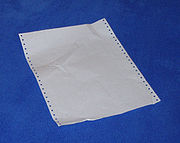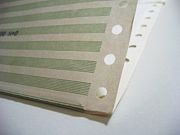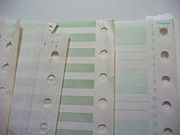
Continuous stationery
Encyclopedia

Paper
Paper is a thin material mainly used for writing upon, printing upon, drawing or for packaging. It is produced by pressing together moist fibers, typically cellulose pulp derived from wood, rags or grasses, and drying them into flexible sheets....
which is designed for use with dot-matrix printers and line printer
Line printer
The line printer is a form of high speed impact printer in which one line of type is printed at a time. They are mostly associated with the early days of computing, but the technology is still in use...
s. Other names for continuous stationery include fan-fold paper, sprocket feed paper, burst paper, tractor-feed paper, and pin feed paper. It can be woodfree uncoated paper (single ply) or carbonless copy paper
Carbonless copy paper
Carbonless copy paper , non-carbon copy paper, or NCR paper is an alternative to carbon paper, used to make a copy of an original, handwritten document without the use of any electronics...
(multi ply).
Shape and Form

Paper
Paper is a thin material mainly used for writing upon, printing upon, drawing or for packaging. It is produced by pressing together moist fibers, typically cellulose pulp derived from wood, rags or grasses, and drying them into flexible sheets....
is perforated
Perforation
A perforation is a small hole in a thin material or web. There is usually more than one perforation in an organized fashion, where all of the holes are called a perforation...
transversely at regular intervals with a line of small slits which form a tear edge that defines the top and bottom of each page. When unfolded into a flat continuous sheet, this slit perforation closes up to allow the printer to print across the perforated edge without stopping or jamming.
The paper is fed vertically through the printer, with the edges of the continuous paper forming the left and right edges of the page.
The paper is also punched longitudinally along both side edges with 5/32-inch (4 mm) diameter engagement holes at a regular 1/2-inch spacing. These holes engage with sprocket
Sprocket
A sprocket or sprocket-wheel is a profiled wheel with teeth, cogs, or even sprockets that mesh with a chain, track or other perforated or indented material. The name 'sprocket' applies generally to any wheel upon which are radial projections that engage a chain passing over it...
wheels or toothed belts, which push or pull the paper through the printer. The holes can either be of a serrated edge pattern (older production machinery) or with smooth plain edges (New Generation production method).
Better quality continuous paper also includes additional longitudinal slit perforations alongside the engagement holes, allowing the large holes to be torn off the printed page, allowing a general approximation to cut-sheet paper typically used in a press, typewriter, or other sheet-fed printer. File or ring binder holes
Hole punch
A hole punch is a common office tool that is used to create holes in sheets of paper, often for the purpose of collecting the sheets in a binder or folder.The origins of the hole punch date back to Germany via Matthias Theel, where two early patents for a...
can also be added to the main body of the form to allow for storage once the form has been divided in to individual sheets.
Common types
The highest grade of continuous paper uses a heavy bond weight similar to typing paper. It uses a very fine perforation of tiny pinholes, and is pre-scored along the perforations. After printing, it is folded along the scored edge to weaken the paper, and then torn off. The fine row of perforations tear off as a very smooth edge that simulates the edge quality of normal cut-sheet typing paper, without the jagged appearance of cheaper long-slit perforations.The cheapest grade of continuous paper is commonly referred to as green bar or music paper. It is a very lightweight bond, and the engagement holes cannot be removed. On one side are regularly spaced horizontal stripes of light green ink, used to help guide the eye of a person reading across many columns of printed data.
Commons sizes:
- 241mm x 279mm (9.5in x 11in)
- 381mm x 279mm (15in x 11in)
Separation and Binding

A burster is a machine that separates one-part continuous paper into separate, individual sheets along the perforations. A burster was typically used with printed continuous-fed paper used in mass-mail advertising. Bursting is done by firmly gripping the second-to-last sheet, and feed rollers grip the last sheet firmly and pulls it away to burst the perforation. The continuous forms then advance into the feed rollers to burst the next sheet. Bursting is often a high-speed process that allows the continuous sheets to feed in at a steady rate, with burst pages either stacked or fed into a single-sheet conveyance to the next paper processing stage. Burster equipment and paper manufactures had to generate perforation specifications so that the paper perforations reliably separated under the force of pulling the sheets apart and not tear down into the printed part of the sheet.
When used to print large continuous documents, they might not be split into separate sheets. By continuously folding two single sided printed sheets back-to-back and binding together a stack of continuous-feed paper along one of the folded edges, it is possible to flip through the stack like a book of double-sided printed pages. With this technique, the stack of papers is normally flipped top to bottom or bottom to top rather than side to side.
History
This paper type was used with tabulating machineTabulating machine
The tabulating machine was an electrical device designed to assist in summarizing information and, later, accounting. Invented by Herman Hollerith, the machine was developed to help process data for the 1890 U.S. Census...
s beginning in the 1920s, and its use grew with the introduction of commercial computers in the 1950s. IBM cards, preprinted, optionally numbered and pre-punched, were available as continuous form cards and were used for checks and other documents. Continuous form paper became widely used and well-known to the general public in the 1980s due to the development of microcomputer
Microcomputer
A microcomputer is a computer with a microprocessor as its central processing unit. They are physically small compared to mainframe and minicomputers...
s and inexpensive dot-matrix
Dot matrix printer
A dot matrix printer or impact matrix printer is a type of computer printer with a print head that runs back and forth, or in an up and down motion, on the page and prints by impact, striking an ink-soaked cloth ribbon against the paper, much like the print mechanism on a typewriter...
consumer printers.
Continuous form paper began to disappear from the consumer market in the 1990s as desktop publishing
Desktop publishing
Desktop publishing is the creation of documents using page layout software on a personal computer.The term has been used for publishing at all levels, from small-circulation documents such as local newsletters to books, magazines and newspapers...
, and WYSIWYG
WYSIWYG
WYSIWYG is an acronym for What You See Is What You Get. The term is used in computing to describe a system in which content displayed onscreen during editing appears in a form closely corresponding to its appearance when printed or displayed as a finished product...
document generation became more popular and widespread. Consumers were willing to pay more to get a laser printer
Laser printer
A laser printer is a common type of computer printer that rapidly produces high quality text and graphics on plain paper. As with digital photocopiers and multifunction printers , laser printers employ a xerographic printing process, but differ from analog photocopiers in that the image is produced...
or inkjet printer
Inkjet printer
An inkjet printer is a type of computer printer that creates a digital image by propelling droplets of ink onto paper. Inkjet printers are the most commonly used type of printer and range from small inexpensive consumer models to very large professional machines that can cost up to thousands of...
that could produce near-typeset-quality documents. These printers accept standard size
Paper size
Many paper size standards conventions have existed at different times and in different countries. Today there is one widespread international ISO standard and a localised standard used in North America . The paper sizes affect writing paper, stationery, cards, and some printed documents...
cut sheets (letter, legal or A4) of paper and don't require continuous form paper. Continuous form paper continues to be used in specialty commercial and industrial markets and, as of 2011, is still available from large office suppliers such as OfficeMax
OfficeMax
OfficeMax , is an American office supplies retailer that was founded in 1988 and is headquartered in Naperville, Illinois.-History:On April 1, 1988, OfficeMax was founded in Cleveland, Ohio, by Bob Hurwitz and Michael Feuer. Hurwitz served as executive chairman and chief executive officer and Feuer...
.

